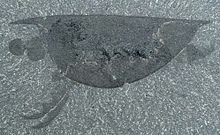Isoxys
| Isoxys Temporal range:
| |
|---|---|

| |
| Isoxys volucris of the Sirius Passet biota | |
| Scientific classification | |
| Kingdom: | |
| Phylum: | |
| Family: | |
| Genus: | Isoxys Walcott, 1890
|
| Species | |
| |
Isoxys (meaning "equal surfaces") is a genus of extinct, pelagic bivalved arthropod; the various species may have been roam-swimming predators.[3] It had a pair of large spherical eyes (which are the most commonly preserved feature of the soft-bodied anatomy),[1] and two large appendages[3] It is possible that these appendages are homologous to the great appendages of radiodonts and megacheirans.[4]


Ecology[]
Isoxys was abundant in tropical seas,[5] and may have had a global distribution.[3] Eyes of different specimens appear to have been adapted to different light intensities; one specimen of I. auritus was either crepuscular in shallow water, or lived in waters around 140 m below the sea surface; whereas another was morphologically adapted to a diurnal light intensity in shallow waters.[6] It is likely that Isoxys was a visual predator that hunted swimming above the seafloor. It had powerful prehensile frontal appendages and large spherical eyes. Isoxys could propel itself by beating possibly 14 flippered swimming legs ( exopods) and steer with a flap-like tail (or telson).[3]
Species[]
There are a number of species of Isoxys.[7] I. volucris is the most abundant in the Sirius Passet locality; I. auritus is found in China.[5] In addition to a single specimen of I. longissimus, 163 specimens of I. acutangulus – making a total of 164 specimens of Isoxys are known from the Greater Phyllopod bed, where they comprise 0.31% of the community.[8]
Taxonomy[]
Isoxys is thought to be one of the basalmost known arthropods, more basal than members of Megacheira but more derived than members of Radiodonta.[9]
See also[]
- Arthropod
- Cambrian explosion
- Chengjiang biota
References[]
- ^ a b García-Bellido, D.; Vannier, J.; Collins, D. (2009). "Soft-part preservation in two species of the arthropod Isoxys from the middle Cambrian Burgess Shale of British Columbia, Canada" (PDF). Acta Palaeontologica Polonica. 54 (4): 699. doi:10.4202/app.2009.0024. S2CID 53613716.
- ^ Liu, Q.; Luo, H.-L.; Chen, L.-Z.; Lu, S.-X. (2006). "Panlongia, a new trilobitomorph genus from the Lower Cambrian, Kunming, Yunnan". Acta Palaeontologica Sinica. 45: 384–392.
- ^ a b c d Vannier, J.; Garcia-Bellido, C.; Hu, X.; Chen, L. (Jul 2009). "Arthropod visual predators in the early pelagic ecosystem: evidence from the Burgess Shale and Chengjiang biotas". Proceedings: Biological Sciences. 276 (1667): 2567–2574. doi:10.1098/rspb.2009.0361. ISSN 0962-8452. PMC 2686666. PMID 19403536.
- ^ Aria, Cédric; Zhao, Fangchen; Zeng, Han; Guo, Jin; Zhu, Maoyan (December 2020). "Fossils from South China redefine the ancestral euarthropod body plan". BMC Evolutionary Biology. 20 (1): 4. doi:10.1186/s12862-019-1560-7. ISSN 1471-2148. PMC 6950928. PMID 31914921.
- ^ a b Stein, M.; Peel, J. S.; Siveter, D. J.; Williams, M. (2009). "Isoxys (Arthropoda) with preserved soft anatomy from the Sirius Passet Lagerstätte, lower Cambrian of North Greenland". Lethaia. 43 (2): 258. doi:10.1111/j.1502-3931.2009.00189.x.
- ^ Schoenemann, B.; Clarkson, E. N. K. (2010). "Eyes and vision in the Chengjiang arthropod Isoxys indicating adaptation to habitat". Lethaia. 44 (2): no. doi:10.1111/j.1502-3931.2010.00239.x.
- ^ Julien Kimmig & Brian R. Pratt (2015). "Soft-bodied biota from the middle Cambrian (Drumian) Rockslide Formation,Mackenzie Mountains, northwestern Canada". Journal of Paleontology. 89 (1): 51–71. doi:10.1017/jpa.2014.5. S2CID 130268424.
- ^ Caron, Jean-Bernard; Jackson, Donald A. (October 2006). "Taphonomy of the Greater Phyllopod Bed community, Burgess Shale". PALAIOS. 21 (5): 451–65. doi:10.2110/palo.2003.P05-070R. JSTOR 20173022.
- ^ Legg, David A.; Vannier, Jean (October 2013). "The affinities of the cosmopolitan arthropod Isoxys and its implications for the origin of arthropods". Lethaia. 46 (4): 540–550. doi:10.1111/let.12032.
External links[]
- "Isoxys acutangulus". Burgess Shale Fossil Gallery. Virtual Museum of Canada. 2011.
- Burgess Shale fossils
- Cambrian arthropods
- Burgess Shale animals
- Maotianshan shales fossils
- Paibian
- Cambrian genus extinctions
- Wheeler Shale
- Paleozoic life of the Northwest Territories